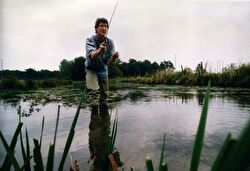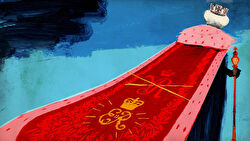
Like, I’m sure, most FT Weekend readers, I spent last Sunday at Ikea, on the North Circular Road in Wembley. It is not an experience to be enjoyed by those who appreciate peace and solitude. But at least there is food to be had.
A poster on the cafeteria wall advertises that traditional Scandinavian delicacy, salmon.
“Good and Good For You”, the ad claims, followed by lots of stuff about the benefits of fatty acids, antioxidants and vitamins. The poster is not unusual: salmon has long been sold on the prospect of cleanliness and health. The fantasy is that it comes to your table fresh from wild seas.
The impression is fraudulent. Most salmon arrives in the kitchen not from untamed nature but from cages in the sea. You cannot see the end of the salmon’s tail in the Ikea poster, because it is covered in fishmonger’s ice.
If this dead fish lived a typical life, the tail will be a raggedy thing.
But then, a farmed salmon doesn’t need much of a tail, because it has nowhere much to swim. The 250 salmon farms on the western coast of Scotland may be set in one of the most magnificent wildernesses in Europe, but the farmed salmon has no freedom. A single circle of mesh measuring 40 metres across may contain up to almost 70,000 fish; on a farm of 12 cages that is getting on for a million fish. It is like a series of floating battery hen sheds.
You do not hear animal rights activists protesting because it is the misfortune of fish not to be cuddly, not to make audible sounds, to have no eyelids and to live in an alien environment. That is their lot.
I freely confess there is something absurd about the fact that the only defenders of fish freedoms are those who want to catch them.
But that’s how it is: there is nothing to stop the heart like the sight of a silver salmon, fresh from the sea, leaping up a river on its journey to its spawning redds. In decades of chasing these untameable animals (and learning to respect their contempt for the flies I have spent hours tying) the prospects for these fish look as bleak as they have ever been.
There are plenty of theories to explain why wild salmon seem imperilled. Ghillies tell tales of ghost trawlers from Russia just over the horizon. Environmentalists talk of global warming changing sea temperatures. The truth is no one knows the overall picture. But one thing is observable: salmon farms have done enormous harm.
Last Tuesday, Salmon and Trout Conservation Scotland announced a collapse in the number of wild salmon returning to spawn in the most closely monitored river in the western Highlands. The river Awe is a short, pretty river on which a fish counter was installed when a hydroelectric dam was constructed, so the figures are accurate.
This year those numbers are the lowest recorded. A similar disaster has hit other west-coast rivers, while those on the east coast have been unaffected. (The salmon farms are all on Scotland’s west coast.) Conservationists are confident of the cause of the decline: young salmon beginning their oceanic migration must pass dozens of cages at sea where captive fish are bred for the table.
Wild salmon do not return to rivers like the Awe because they were killed at the start of their migration to sea.
Only a few decades ago, you ate Atlantic salmon if you were lucky enough to be a toff, or one of his employees. Now it is ubiquitous, piled high in supermarket fridges or lying pink and flabby on plates at wedding receptions and awards dinners. The discovery of how to farm fish by the hundreds of thousands has revolutionised the food industry.
But when you rear fish in the quantities necessary to meet growing demand, you start playing with the environment. Confining naturally migratory and carnivorous animals in packed pens produces enormous quantities of faeces, which covers the seabed beneath.
The cages provide ideal breeding grounds for the sea louse, which, smaller than a fingernail, eats into the salmon’s skin and either directly or indirectly (by exposing them to infections) kills them.
Unfortunately, the salmon farmers like to site cages close to the shore, where they are easier to manage. Often the farms are in estuaries, where the tidal flows that might wash away residues are smaller than in the open sea. Salmon and trout migrating to sea or returning to their natal rivers to spawn must swim through clouds of sea lice.
In 1987, a salmon farm opened in Loch Ewe, surrounded by the mountains of Wester Ross, setting for John Buchan’s novel John Macnab. Loch Maree, a freshwater loch at the head of the river emptying into Loch Ewe, was at the time a world-famous destination for anglers trying to catch sea trout, its hotel booked 12 months or more in advance. But the year after the salmon farm opened, the number of sea trout caught in Loch Maree collapsed. It has never recovered. The fishermen and the boatmen disappeared too.
A report by Andrew Walker, formerly of the Scottish government’s Fisheries Research Services, reached the cautious conclusion that “the introduction of salmon farming in Loch Ewe played a prominent part” in the disappearance of sea trout. It is a similar picture on many, previously prolific, West Coast salmon rivers. Salmon runs on west coast rivers have fallen by about half.
Responding to the reports of environmental damage the industry began to try to kill off the sea lice with chemicals. Unsurprisingly the lice began to develop a resistance to the chemicals, which meant they had to be used in greater quantities. One of the latest weapons is Azamethiphos, an organophosphate, belonging to the same toxic family as pesticides, herbicides and some nerve agents. The most popular chemical at present seems to be “Slice”, whose active ingredient is emamectin benzoate, a powder added to the salmon feed to kill the parasites.
The industry argues that it leads to the creation of thousands of jobs. There’s certainly no denying fish farming has been a commercial success story. By 2015, the Scottish industry was producing nearly 180,000 tons of salmon. The Scottish government hopes production will double in value by 2030. It has bought the argument that fish farming offers a way of creating employment in the wilderness communities essential to Scotland’s sense of itself. But that is an exaggerated claim and anyway, so does angling. The salmon farms are highly automated and according to the Scottish government’s 2015 fish farm production survey, total full-time employment in marine salmon farms amounts to a mere 1,256 jobs in an economically active population of 3.5m. It is less than 1 per cent of those employed by the NHS in Scotland.
Yet the Edinburgh government looks to have decided it is more important to let the farmers have what they want than to heed environmentalists. The Scottish Environment Protection Agency had been discussing whether to ban emamectin. But after pressure from the salmon farmers on the Scottish government, the agency says it is now merely “tightening conditions for the medicine’s use”. For what it’s worth, a committee of the Scottish parliament has decided to hold its own inquiry into the effects of fish farming.
This “Scottish” industry is largely controlled by half-a-dozen Norwegian companies, which are able to benefit from the fact that environmental standards in Scotland are often lower than those at home. Their salmon reaches the supermarkets under names that emphasise supposed Highland origins. Marks and Spencer salmon, for example, carries the brand name Lochmuir. Loch Muir does not exist.
Loch Duart Salmon, a comparatively small, British-owned producer, does at least take its name from a genuine (and rather beautiful) geographical feature.
When I visited one of its farms, it seemed alive to the industry’s environmental image problems. Loch Duart is a top-end producer, supplying expensive restaurants. It keeps fewer fish in each cage and allows longer periods than many for the pens to lie fallow between use. In a hatchery onshore it was rearing lumpfish, which feed on the lice. Elsewhere were tanks of wrasse, a species even lower down the index of sexy fish, but which are “cleaner fish” that eat the lice.
Yet even Loch Duart uses chemicals (though it prefers to call them “medicines”) on its fish. The latest report from the Scottish Salmon Producers’ Organisation showed Loch Duart farms in the north-west Highlands to have the highest adult female sea lice infestations in March in Scotland. The company says it was an unexpected spike, and that its new, non-chemical, approach using “cleaner fish” has ensured that all its farms are below industry chemical-treatment trigger levels.
There are two very obvious solutions, if people wish to continue eating farmed salmon.
One is to locate the cages in deeper water with stronger currents, much further offshore. It would be inconvenient for the industry, but it might stop pollution by lice and chemicals. The more radical solution is for salmon farming to be in tanks on land, with arrangements for waste disposal.
Geography, though, is an insuperable problem. Salmon farming has political appeal because it seems to offer employment in these Highland communities that have a powerful romantic hold over Scottish identity. Once you use land-based systems, with manufactured salt water, why locate them in the Highlands at all? It could be much more economical to build them somewhere near the markets of southern England or the airports supplying export destinations.
Would you buy Loch Hounslow salmon?



